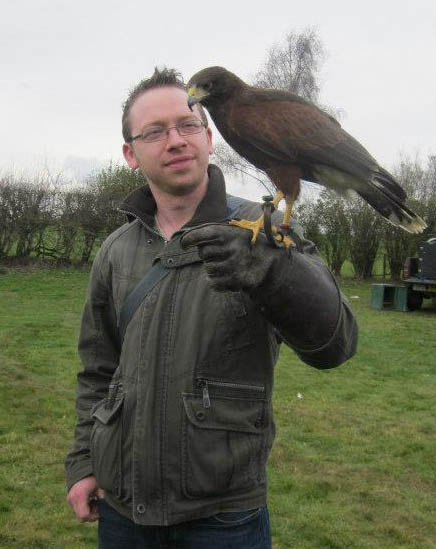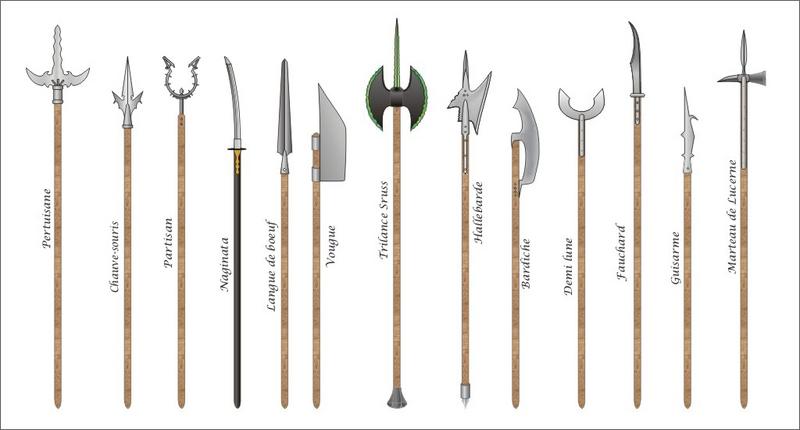The Polearm in History
The Polearm in History
by Mark Latham
Before we immerse ourselves in the sport of Polearmball, let’s take a look at the polearm itself. What is this archetypal weapon? Why was it developed and how was it used? And just why does it have such a resonance even today, in a world where computers are more effective weapons than steel blades?
Firstly, what is a polearm? Well, as the name suggests, it is a weapon whose fighting blade is positioned on the end of a long pole, usually a wooden shaft. The head of a polearm can take all manner of forms, though it’s usually bladed. The blade is always perpendicular to the shaft, so it’s used in a kind of chopping motion – this is different from a spear or pike, which comes to a point and is used for stabbing. This isn’t to say that polearms can’t contain spear points – many do – but the inclusion of a point is secondary.
Polearms were one of the most common weapons on European battlefields in the 14th and 15th centuries. They were easy to make and maintain, versatile in the roles they could perform, and simple to use as long as you had a strong arm. They were not the weapons of the lone, swashbuckling warrior, but were rather the primary weapon of the common soldier. They would have been seen in their thousands, carried by huge blocks of men assembled in ranks, ready to fight for their king or province.
The polearm that most people are familiar with today is the inimitable halberd. You’ll have seen this weapon in countless computer games, tabletop wargames and pen n’ paper roleplaying games. The Swiss Guard who stand sentry outside the Vatican still carry them as ceremonial weapons. They adorn the walls of castles across Europe. Remember the scene in the Two Towers movie when the Easterling army marches to war? They all carried halberds. Even if you didn’t know what they were called until now, you’ll have seen halberds everywhere! These weapons have an axe head sited at the end of a long pole, usually with a spike on the top and a wicked, hook (or ‘thorn’) on the back edge. The name comes from two German words: ‘Halm’ (staff) and ‘Barte’ (axe), and its primary purpose was to hack at opposing troops in mass battle situations. The spear point was used to deter charging cavalry, and the thorn was designed to snare cavalrymen who rode too close and pull them from their steeds, where they’d be finished off on the ground by a swift chop from the axe head.
The halberd wasn’t the only polearm on medieval battlefields by any stretch, although it was by far the most prolific. In fact, you only have to flick through a Dungeons & Dragons manual or click through Wikipedia to see a huge list of polearms that are very similar in design to halberds, but were found all over the world. Some of them, like the bardiche, were variations on the theme – these had a large axe-head, but no spear tip or thorn, as they were designed to make chopping strikes easier. Others, however, such as the Chinese ji, or the Japanese bisento, seem to have been developed independently, but along very similar lines. Either the fame of the weapon travelled across continents, or far-flung cultures hit upon the same problems of warfare, and came up with very similar solutions.
There are several other classes of polearm, of course. Some, like the three-pronged ranseur and corseque, were derived from spears, or even tridents, and became specialized weapons for dragging opponents from horses or disarming them by trapping their weapons within the prongs. Glaive polearms are slightly different again – the bardiche, mentioned earlier, is really a type of glaive – this category always has a single-edged blade atop the pole. Glaives with very small blades, such as the bill or guisarme, can be mistaken for spears at first glance, though they are designed for hacking at distance rather than thrusting. In 1599, the English gentleman George Silver – famous for his writings on the martial arts – ranked a huge list of traditional weapons against each other, and determined that the glaive was perhaps the most effective hand-to-hand combat weapon to exist! Like other polearms, glaives were not confined to Europe – probably the most famous glaive-type weapon in history is the Japanese naginata, wielded with great flourish by the samurai. This weapon resembles a katana attached to the end of a pole, and was deadly in the hands of a trained soldier.
This is what’s really interesting about polearms – they didn’t just spring into being overnight; they existing during a very specific time period, and were constantly refined and perfected into the ultimate infantry weapon. It didn’t matter what country you were from either – in the 14th and 15th centuries warfare was growing in scale. Feudal lords were being forced to press more and more common men into service, and these men – often youths – were no match for elite troops and armored cavalry. The polearm was the solution to that problem; a great leveler on the battlefield. Sure, polearms had been around for a while (the fauchard, for example, with its wicked sickle blade, was first seen in 11th century Europe), but the designs evolved constantly to meet new threats, or to keep manufacturing speed and costs down. When the medieval period gave way to the Renaissance, even the trusty halberd was found wanting against plate-armored knights. The answer? Adapt the design. The heavy poleaxe – similar in many ways to the halberd – was a good starting point, and featured axe, hammer and spear point in various combinations to skewer, bash and unseat onrushing knights. It was so successful that it continued to be used well into the 16th century, and gave rise to the popularity of the bec de corbin and the lucerne hammer – polearms that were designed for bashing rather than hacking.
In the present day, of course, there’s no call for bashing knights from their warhorses, or chopping your enemies in half with an axe-stroke. But the polearm has continued to develop in the imagination – in Polearmball, the glaive has evolved into the Javel, and the soldiers are the players. The javel is the next step in the development of one of history’s most enduring sports implements, and this time it’s a polearm designed to be thrown as well as wielded up close, as a piece of unique new sports equipment for a unique new sport!
The image of the polearm is an enduring one – a ‘fan favorite’ with many students of history and players of roleplaying games across the world. Primarily, this is because it’s the weapon of the common man. With a polearm, even the lowliest soldier can take down a knight who is worth ten of him on the battlefield. In the annals of history, is it really fair that the knightly lords are hailed as heroes or even saints, whilst the man-at-arms, armed only with a halberd and his courage – are forgotten? The real heroes were those brave men who stood resolute in the face of an oncoming cavalry regiment, polearms at the ready. The polearm symbolizes triumph in the face of adversity, and that’s something that we can all relate to, and aspire to.
Mark Latham
Mark Latham is an author, editor and games designer from Staffordshire, UK. Formerly the editor of Games Workshop’s White Dwarf magazine and head of Warhammer 40,000 in the games development team, Mark is a writer of short stories, books and tabletop games, such as Legends of the Old West, and Waterloo. Mark has been ensconced in the worlds of science fiction and fantasy for many years, but his real passion is for history. Mark has a deep obsession with the past, especially the nineteenth century; an affliction that can only be salved by writing on the subject for far longer than can be considered healthy.
Mark's web sites are here: thelostvictorian.blogspot.co.uk
and here: facebook.com/thelostvictorian

